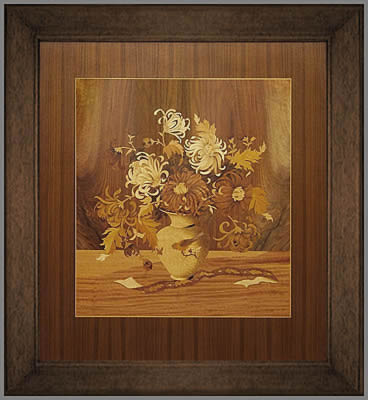|
 |
|
Our April update features a rather large example of the ever popular ""Chrysanthemums" flower picture by the Buchschmid and Gretaux Wood Inlay Company.. |
Our April update features a rather large version of the ever popular ""Chrysanthemums" flower basket picture produced by the Buchschmid and Gretaux Wood Inlay Company in the late 1950's to early 1960's.
As we say, this version of the Chrysanthemums wood inlay picture is not the usual 29 x 25 inches, this one measures 33 x 30.5 inches - which is more than 4 inches larger all round. This superb example of the Buchschmid and Gretaux Wood Inlay picture work is owned by Karen Healy. Karen actually has every piece of the original paper work in her possesion, which is unusual after nearly 60 years of the picture's existence. Karen's parents purchased this picture around 1960 while in Germany. The paperwork, being printed on wood pulp paper is obviously a wee bit fragile now, but it is a wonderful historic set of documents nonetheless. We have taken the liberty of copying out the text from the document which tells the story of how the wood inlay pictures were made in those days. The process is somewhat different to today's practices, but the principles are still the same. It is interesting to note that Buchschmid and Gretaux worked on the inlay from the reverse and then flipped it when they mounted the inlay to the baseboard. The reason for this we assume is that the clean "unworked" side of the inlay now becomes the front and all the glue and tracing lines are now hidden on the side of the inlay which is affixed to the plywood baseboard. |
|
|||
Information on the valuation of Wood Inlay or Marquetry pieces Please note that we (The Marquetry Society) are unable to give market reference valuations on any marquetry, or wood inlay works, or pieces of any kind. Quick Links to the other pages in this series: or select another Can we Help? page: 1 to 50 (select from menu at bottom of each page) 51 | 52 | 53 | 54 | 55 | 56 | 57 | 58 | 59 | 60 | 61 | 62 | 63 | 64 | 65 | 66 | 67 | 68 | 69 | 70 | 71 | 72 | 73 | 74 | 75 | 76 | 77 | 78 |
- |
|||
If you are using a different E-mail system to the M/S Outlook Express that our link boxes are utilising and your e-mail client will not open when you click the box, just copy and paste the following address into your "send to" box: info@marquetry.org or, if that is not possible, then just type it in as seen above, thanks. |
